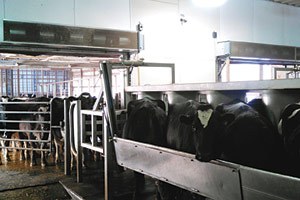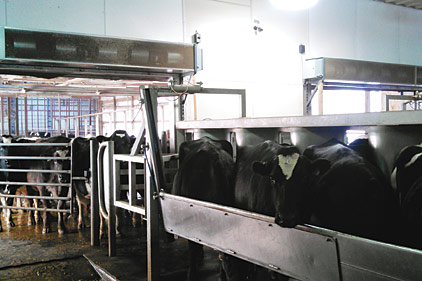Holy cow! Milking parlors on dairy farms are yet another application for air curtains, the energy-saving devices that keep outdoor and indoor environments separate at open doorways. After decades of energy-saving applications for industrial openings and, more recently, for commercial building entrances such as hospitals, hotels, and schools, air curtains now have been proven successful at preventing milking parlor equipment freeze-ups on dairy farms.
Wisconsin Winters

|
| Dairy farmer Hans Griesen was losing product and productivity due to freezing wintertime temperatures at his Madison, Wisconsin, milking parlor until he installed two air curtains at the open doorways, saving upward of $28,000 annually in operational energy costs. |
Milk productivity setbacks were frequent challenges from November through March during subfreezing days for Griesen’s Family Dairy, located 60 miles northwest of Madison, Wisconsin, in Prairie du Sac, Wisconsin. The medium-sized, 680-cow farm suffered product losses and production delays caused when automatic milking equipment nearest the parlor entrances would freeze. The icy conditions also led to slippery floors and poor indoor comfort, both deemed hazardous for employees.
Staff members at Bernie’s Equipment Co., Holmen, Wisconsin — a local equipment dealer — recommended air curtains by Berner Intl., New Castle, Pennsylvania, to retain heat in the milking parlor.
On ambient temperature days above 32?F, the floor’s radiant system, supplied by a 400,000-Btu, stainless steel, 95.1 percent efficient Munchkin boiler manufactured by Heat Transfer Products Inc., combined with each cow’s inherent 4,000-Btuh heat output to adequately maintain the milking parlor’s target temperature range of 38?-40?. The heating system was adequate, despite the fact that co-owner Hans Griesen prefers the two 16-by-8-foot entryways to remain open through three daily shifts for optimum productivity and animal movement in and out of the 24-stall herringbone-style milking parlor. On subfreezing days, however, the heating system couldn’t maintain set-point temperatures near the entryway.
Griesen first tried portable salamander forced-air heaters. The entrances were warmer; however, the $100-per-day cost for fuel, kerosene emission odors, and potential fire hazard sent Griesen looking elsewhere. Staffing an employee to open and close the two doorways all day was considered cost prohibitive, even at minimum-wage rates, according to Griesen.
Griesen also considered both strip curtains and air-curtain technology so the entry doors could remain open. Strip curtains were too obstructive to the animals.
His first review of an air curtain at a nearby farm wasn’t a positive experience, either. The farm used an inexpensive air curtain brand with short lengths bolted in tandem to span the wide doorway. The air curtain was noisy, its modular construction vibrated, and it didn’t provide the proper volume, velocity, or uniformity of air stream to prevent outdoor air infiltration, according to Griesen.
Finally, Clyde Conger, Bernie’s general sales manager, and Berner manufacturer’s representative Tim Spreda, vice president, sales, MII Equipment, Milwaukee, worked with factory sales engineers to specify two American-made,16-foot-long, one-piece air curtains from Berner’s VSA model product line. The air curtains are mounted above the milking parlor’s open doorways and retain up to 80 percent of the facility’s energy, even during wind loads of up to 5 mph. Each air curtain features a corrosion-resistant powder-coated finish, five high-efficiency 1/2-horsepower motors, and a welded aluminized steel frame that retains a strong structural integrity that spans across such a wide opening. Consequently, there are no gaps in the 7,631-cfm, 1,635-fpm airstream it provides across the 16-foot-wide entryways.
“Hans had already educated and sold himself on the air curtain concept before we got involved; therefore, he knew exactly what he wanted and had designed the application in his head,” Conger said.
“Some of our coworkers were skeptical as to whether air curtains would solve the problem, but they’re believers now, since we haven’t had any more frozen equipment issues,” said Griesen, who hired a carpenter to reinforce the doorway headers that receive the air curtain support brackets. “One employee took infrared color temperature readings, and there was a big difference in the temperature inside the doorway with the air curtains on and off.”
Air curtains consist of fan motors, blowers, nozzles, directional vanes, and a control package. When properly engineered for the proper horsepower, nozzle discharge, and airstream angle, an air curtain essentially seals a doorway from outdoor elements, flying insects, and dust. The airstream must strategically break at the threshold of the doorway for ultimate performance. While air curtains are typically activated by a plunger switch after a door opens, the milking parlor air curtains are activated by a thermostat located near the entrance. Gas-fired hot water or steam and electric heating-coil options were considered; however, Griesen felt the milking parlor’s radiant heat system was sufficient.
Although Griesen’s main concern was subfreezing air infiltration, the air curtains are also saving the facility energy, because the radiant floor system’s boiler cycles on less to maintain the set point temperature.
The air curtains supplement the overall cutting-edge energy-efficiency design and construction conception when the Griesen family relocated from the Netherlands to build the 40-acre farm from the ground up in 2005. Other technologies used on the farm include energy-efficient metal halide fixtures with lamps by Sylvania; a variable-frequency drive on the milking vacuum pump; four scroll compressors by Copeland, a division of Emerson Climate Technologies, for milk refrigeration; and two heat exchangers for compressor heat recovery and a plate cooler, both by DeLaval/Germania.
The efficient equipment combined saves the farm an estimated $35,000 annually in energy savings, according to Griesen.
While the milk producers association, the Dairy Council of California, continually broadcasts its “Got Milk?” campaign to advertise milk’s benefits to consumers, Griesen’s air curtain success should prompt dairy farmers to ask themselves, “Got Air Curtains?”
Information courtesy of JPF Communications. For more information, email john@jpfcomm.com.
Publication date: 6/9/2014
Want more HVAC industry news and information? Join The NEWS on Facebook, Twitter, and LinkedIn today!


Report Abusive Comment